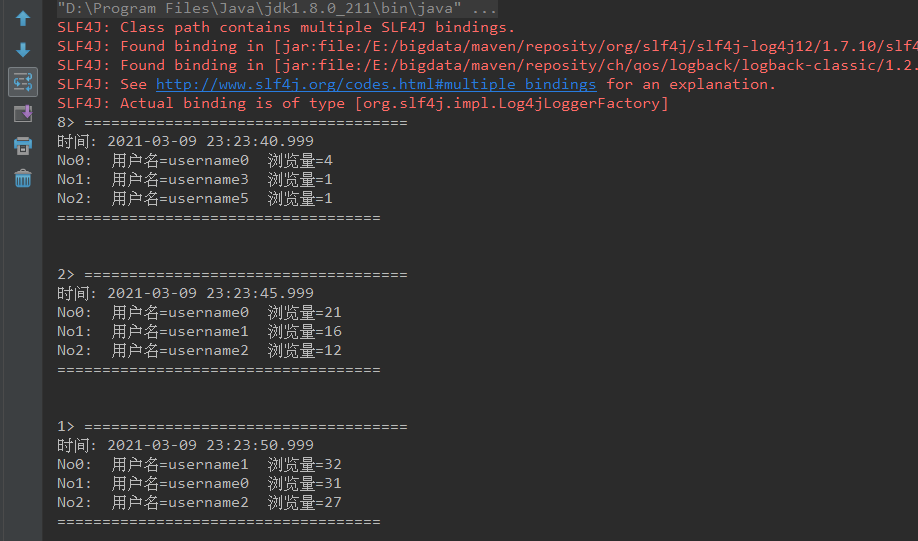Flink实时计算topN热榜
topN的常见应用场景,最热商品购买量,最高人气作者的阅读量等等。
1. 用到的知识点
Flink创建kafka数据源;
基于 EventTime 处理,如何指定 Watermark;
Flink中的Window,滚动(tumbling)窗口与滑动(sliding)窗口;
State状态的使用;
ProcessFunction 实现 TopN 功能;
2. 案例介绍
通过用户访问日志,计算最近一段时间平台最活跃的几位用户topN。
创建kafka生产者,发送测试数据到kafka;
消费kafka数据,使用滑动(sliding)窗口,每隔一段时间更新一次排名;
3. 数据源
这里使用kafka api发送测试数据到kafka,代码如下:
@Data
@NoArgsConstructor
@AllArgsConstructor
@ToString
public class User {
private long id;
private String username;
private String password;
private long timestamp;
}
Map<String, String> config = Configuration.initConfig("commons.xml");
@Test
public void sendData() throws InterruptedException {
int cnt = 0;
while (cnt < 200){
User user = new User();
user.setId(cnt);
user.setUsername("username" + new Random().nextInt((cnt % 5) + 2));
user.setPassword("password" + cnt);
user.setTimestamp(System.currentTimeMillis());
Future<RecordMetadata> future = KafkaUtil.sendDataToKafka(config.get("kafka-topic"), String.valueOf(cnt), JSON.toJSONString(user));
while (!future.isDone()){
Thread.sleep(100);
}
try {
RecordMetadata recordMetadata = future.get();
System.out.println(recordMetadata.offset());
} catch (InterruptedException e) {
e.printStackTrace();
} catch (ExecutionException e) {
e.printStackTrace();
}
System.out.println("发送消息:" + cnt + "******" + user.toString());
cnt = cnt + 1;
}
}
这里通过随机数来扰乱username,便于使用户名大小不一,让结果更加明显。KafkaUtil是自己写的一个kafka工具类,代码很简单,主要是平时做测试方便。
4. 主要程序
创建一个main程序,开始编写代码。
创建flink环境,关联kafka数据源。
Map<String, String> config = Configuration.initConfig("commons.xml");
Properties kafkaProps = new Properties();
kafkaProps.setProperty("zookeeper.connect", config.get("kafka-zookeeper"));
kafkaProps.setProperty("bootstrap.servers", config.get("kafka-ipport"));
kafkaProps.setProperty("group.id", config.get("kafka-groupid"));
StreamExecutionEnvironment senv = StreamExecutionEnvironment.getExecutionEnvironment();
EventTime 与 Watermark
senv.setStreamTimeCharacteristic(TimeCharacteristic.EventTime);
设置属性senv.setStreamTimeCharacteristic(TimeCharacteristic.EventTime),表示按照数据时间字段来处理,默认是TimeCharacteristic.ProcessingTime
/** The time characteristic that is used if none other is set. */
private static final TimeCharacteristic DEFAULT_TIME_CHARACTERISTIC = TimeCharacteristic.ProcessingTime;
这个属性必须设置,否则后面,可能窗口结束无法触发,导致结果无法输出。取值有三种:
ProcessingTime:事件被处理的时间。也就是由flink集群机器的系统时间来决定。
EventTime:事件发生的时间。一般就是数据本身携带的时间。
IngestionTime:摄入时间,数据进入flink流的时间,跟ProcessingTime还是有区别的;
指定好使用数据的实际时间来处理,接下来需要指定flink程序如何get到数据的时间字段,这里使用调用DataStream的assignTimestampsAndWatermarks方法,抽取时间和设置watermark。
senv.addSource(
new FlinkKafkaConsumer010<>(
config.get("kafka-topic"),
new SimpleStringSchema(),
kafkaProps
)
).map(x ->{
return JSON.parseObject(x, User.class);
}).assignTimestampsAndWatermarks(new BoundedOutOfOrdernessTimestampExtractor<User>(Time.milliseconds(1000)) {
@Override
public long extractTimestamp(User element) {
return element.getTimestamp();
}
})
前面给出的代码中可以看出,由于发送到kafka的时候,将User对象转换为json字符串了,这里使用的是fastjson,接收过来可以转化为JsonObject来处理,我这里还是将其转化为User对象JSON.parseObject(x, User.class),便于处理。
这里考虑到数据可能乱序,使用了可以处理乱序的抽象类BoundedOutOfOrdernessTimestampExtractor,并且实现了唯一的一个没有实现的方法extractTimestamp,乱序数据,会导致数据延迟,在构造方法中传入了一个Time.milliseconds(1000),表明数据可以延迟一秒钟。比如说,如果窗口长度是10s,0~10s的数据会在11s的时候计算,此时watermark是10,才会触发计算,也就是说引入watermark处理乱序数据,最多可以容忍0~t这个窗口的数据,最晚在t+1时刻到来。

具体关于watermark的讲解可以参考这篇文章
https://blog.csdn.net/qq_39657909/article/details/106081543
窗口统计
业务需求上,通常可能是一个小时,或者过去15分钟的数据,5分钟更新一次排名,这里为了演示效果,窗口长度取10s,每次滑动(slide)5s,即5秒钟更新一次过去10s的排名数据。
.keyBy("username")
.timeWindow(Time.seconds(10), Time.seconds(5))
.aggregate(new CountAgg(), new WindowResultFunction())
我们使用.keyBy("username")对用户进行分组,使用.timeWindow(Time size, Time slide)对每个用户做滑动窗口(10s窗口,5s滑动一次)。然后我们使用 .aggregate(AggregateFunction af, WindowFunction wf) 做增量的聚合操作,它能使用AggregateFunction提前聚合掉数据,减少 state 的存储压力。较之.apply(WindowFunction wf)会将窗口中的数据都存储下来,最后一起计算要高效地多。aggregate()方法的第一个参数用于
这里的CountAgg实现了AggregateFunction接口,功能是统计窗口中的条数,即遇到一条数据就加一。
public class CountAgg implements AggregateFunction<User, Long, Long>{
@Override
public Long createAccumulator() {
return 0L;
}
@Override
public Long add(User value, Long accumulator) {
return accumulator + 1;
}
@Override
public Long getResult(Long accumulator) {
return accumulator;
}
@Override
public Long merge(Long a, Long b) {
return a + b;
}
}
.aggregate(AggregateFunction af, WindowFunction wf) 的第二个参数WindowFunction将每个 key每个窗口聚合后的结果带上其他信息进行输出。我们这里实现的WindowResultFunction将用户名,窗口,访问量封装成了UserViewCount进行输出。
private static class WindowResultFunction implements WindowFunction<Long, UserViewCount, Tuple, TimeWindow> {
@Override
public void apply(Tuple key, TimeWindow window, Iterable<Long> input, Collector<UserViewCount> out) throws Exception {
Long count = input.iterator().next();
out.collect(new UserViewCount(((Tuple1<String>)key).f0, window.getEnd(), count));
}
}
@Data
@NoArgsConstructor
@AllArgsConstructor
@ToString
public static class UserViewCount {
private String userName;
private long windowEnd;
private long viewCount;
}
TopN计算最活跃用户
为了统计每个窗口下活跃的用户,我们需要再次按窗口进行分组,这里根据UserViewCount中的windowEnd进行keyBy()操作。然后使用 ProcessFunction 实现一个自定义的 TopN 函数 TopNHotItems 来计算点击量排名前3名的用户,并将排名结果格式化成字符串,便于后续输出。
.keyBy("windowEnd")
.process(new TopNHotUsers(3))
.print();
ProcessFunction 是 Flink 提供的一个 low-level API,用于实现更高级的功能。它主要提供了定时器 timer 的功能(支持EventTime或ProcessingTime)。本案例中我们将利用 timer 来判断何时收齐了某个 window 下所有用户的访问数据。由于 Watermark 的进度是全局的,在 processElement 方法中,每当收到一条数据(ItemViewCount),我们就注册一个 windowEnd+1 的定时器(Flink 框架会自动忽略同一时间的重复注册)。windowEnd+1 的定时器被触发时,意味着收到了windowEnd+1的 Watermark,即收齐了该windowEnd下的所有用户窗口统计值。我们在 onTimer() 中处理将收集的所有商品及点击量进行排序,选出 TopN,并将排名信息格式化成字符串后进行输出。
这里我们还使用了 ListState<ItemViewCount> 来存储收到的每条 UserViewCount 消息,保证在发生故障时,状态数据的不丢失和一致性。ListState 是 Flink 提供的类似 Java List 接口的 State API,它集成了框架的 checkpoint 机制,自动做到了 exactly-once 的语义保证。
private static class TopNHotUsers extends KeyedProcessFunction<Tuple, UserViewCount, String> {
private int topSize;
private ListState<UserViewCount> userViewCountListState;
public TopNHotUsers(int topSize) {
this.topSize = topSize;
}
@Override
public void onTimer(long timestamp, OnTimerContext ctx, Collector<String> out) throws Exception {
super.onTimer(timestamp, ctx, out);
List<UserViewCount> userViewCounts = new ArrayList<>();
for(UserViewCount userViewCount : userViewCountListState.get()) {
userViewCounts.add(userViewCount);
}
userViewCountListState.clear();
userViewCounts.sort(new Comparator<UserViewCount>() {
@Override
public int compare(UserViewCount o1, UserViewCount o2) {
return (int)(o2.viewCount - o1.viewCount);
}
});
// 将排名信息格式化成 String, 便于打印
StringBuilder result = new StringBuilder();
result.append("====================================\n");
result.append("时间: ").append(new Timestamp(timestamp-1)).append("\n");
for (int i = 0; i < topSize; i++) {
UserViewCount currentItem = userViewCounts.get(i);
// No1: 商品ID=12224 浏览量=2413
result.append("No").append(i).append(":")
.append(" 用户名=").append(currentItem.userName)
.append(" 浏览量=").append(currentItem.viewCount)
.append("\n");
}
result.append("====================================\n\n");
Thread.sleep(1000);
out.collect(result.toString());
}
@Override
public void open(org.apache.flink.configuration.Configuration parameters) throws Exception {
super.open(parameters);
ListStateDescriptor<UserViewCount> userViewCountListStateDescriptor = new ListStateDescriptor<>(
"user-state",
UserViewCount.class
);
userViewCountListState = getRuntimeContext().getListState(userViewCountListStateDescriptor);
}
@Override
public void processElement(UserViewCount value, Context ctx, Collector<String> out) throws Exception {
userViewCountListState.add(value);
ctx.timerService().registerEventTimeTimer(value.windowEnd + 1000);
}
}
结果输出
可以看到,每隔5秒钟更新输出一次数据。

参考
http://wuchong.me/blog/2018/11/07/use-flink-calculate-hot-items/
